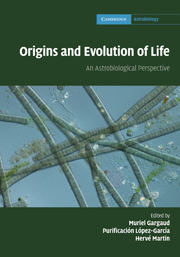Book contents
- Frontmatter
- Contents
- List of contributors
- Foreword
- Preface
- Part I What is life?
- Part II Astronomical and geophysical context of the emergence of life
- Part III The role of water in the emergence of life
- Part IV From non-living systems to life
- 16 Energetic constraints on prebiotic pathways: application to the emergence of translation
- 17 Comparative genomics and early cell evolution
- 18 Origin and evolution of metabolisms
- Part V Mechanisms for life evolution
- Part VI Life in extreme conditions
- Part VII Traces of life and biosignatures
- Part VIII Life elsewhere?
- Index
18 - Origin and evolution of metabolisms
from Part IV - From non-living systems to life
Published online by Cambridge University Press: 04 February 2011
- Frontmatter
- Contents
- List of contributors
- Foreword
- Preface
- Part I What is life?
- Part II Astronomical and geophysical context of the emergence of life
- Part III The role of water in the emergence of life
- Part IV From non-living systems to life
- 16 Energetic constraints on prebiotic pathways: application to the emergence of translation
- 17 Comparative genomics and early cell evolution
- 18 Origin and evolution of metabolisms
- Part V Mechanisms for life evolution
- Part VI Life in extreme conditions
- Part VII Traces of life and biosignatures
- Part VIII Life elsewhere?
- Index
Summary
Introduction: some conceptual remarks on metabolism
Metabolism is the set of enzymatic reactions that allow living beings to use external energy sources to drive the building of their biochemical components from external chemical sources and also to carry out energy-consuming functions, such as osmotic and mechanical work. The role played by gene-encoded enzymatic catalysts is one of the essential properties of life. Since their stability is finite and there is a need for constant replacement, enzymes are themselves products of metabolism (Cornish-Bowden et al., 2004). Thus, the proteome (i.e. the totality of proteins and their concentrations that exists in a particular cell state) is a product of the metabolome (i.e. the totality of metabolites and their concentrations that exists in a particular metabolic state). This situation gives rise to the ‘metabolic circularity’ or ‘recursivity’; a concept needed for a complete understanding of metabolism (Cornish-Bowden et al., 2007).
Extant metabolic networks are certainly complex, with hundreds or thousands of concatenated enzymatic reactions. Since there is a limited number of coenzymes (i.e. the special reactants that help enzymes to perform their catalytic functions), recurrently used by different enzymes, and some central metabolites are true crossroads between different lines of chemical transformation, complex networks emerge. From a topological perspective, metabolic networks show a power-law distribution of connectivity (Fell and Wagner, 2000). In other words, most metabolites are poorly connected whereas a few of them (coenzymes and metabolic crossroads) support many connections.
- Type
- Chapter
- Information
- Origins and Evolution of LifeAn Astrobiological Perspective, pp. 270 - 288Publisher: Cambridge University PressPrint publication year: 2011
- 6
- Cited by



